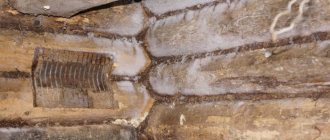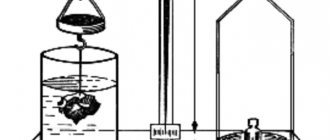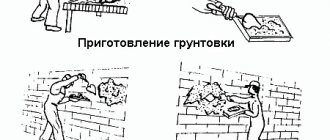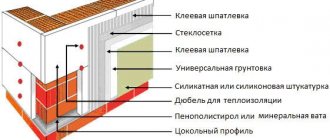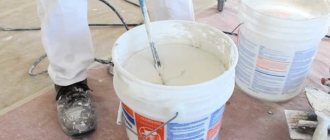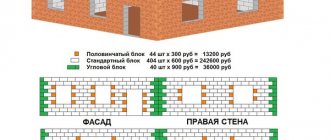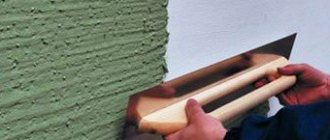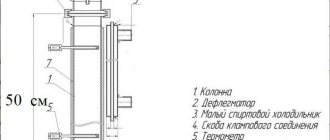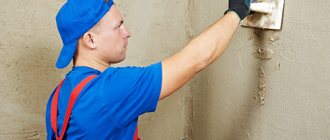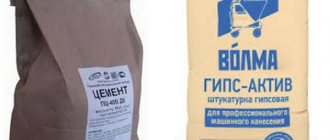GKL or plaster?
A very difficult and, one might even say, philosophical question in the field of construction and finishing works: what to choose for interior wall decoration – plasterboard or plaster? Drywall today is very popular both in the West and in Russia, and there are many times more specialists in working with drywall than good plasterers. However, plaster is still very much in demand. What is this due to: just the conservative tastes of some specialists and their clients, or is it due to the advantages of plaster? Let's try to figure it out and answer the main question: what is better - drywall or plaster?
Plaster
Plastering is a type of finishing work aimed at creating a smooth surface for its subsequent finishing.
Mixtures and solutions for plaster are made from lime (for example, the plaster-lime mixture “Tanilit from StroyBrig”), gypsum (for example, gypsum plaster “Volma Stroy from Volma”) or cement (for example, dry mix m 150 from Baustrol) with the addition of special substances that give the plaster additional properties.
There are several types of plaster: first of all, these are ordinary plasters used for interior and exterior finishing work. Such plasters are divided into simple and improved, and, depending on the presence of special additives, into sound-absorbing and waterproofing.
Plaster can also be decorative - these are colored plasters, which, among other things, contain added pigments or “colors”.
Plasters are also differentiated by their base – it can be aqueous or non-aqueous. The latter include polyurethanes (for all types of work) and epoxy resins (mainly only for interior work) as binding elements. Non-aqueous plaster mixtures are more often used for applying so-called textured plaster.
Plaster: advantages
1. Plastered walls, provided that the work is done well, does not require repairs (except for finishing) for many years (up to 30 years or more).
2. Plastering is not as expensive as people think. Having compared plaster and drywall , or rather, their cost, we came to the conclusion that materials for plaster are almost 2 times cheaper. The work itself is also, in most cases, cheaper (on average 10-30 percent cheaper than installing drywall).
However, the work of a good plasterer is valued more highly. But even in this situation, plaster will cost less, or the cost will be the same.
4. Well-plastered walls are strong, reliable and impact-resistant.
5. If the walls are plastered, there are no problems if you need to hang something on them. Drywall may not withstand high loads, so to hang heavy pieces of furniture or equipment you have to strengthen it.
Plaster: disadvantages
1. Plastering involves “wet work,” while installation of gypsum boards (plasterboard sheets) is “dry work.” If you have to choose between dry and wet work, preference, for obvious reasons, is often given to the former.
2. Plastering can take a long time - this depends, first of all, on the initial quality of the walls and the experience of the plasterer. Installation of drywall usually proceeds without difficulties, regardless of the quality of the walls, and requires significantly less time.
3. If the walls are uneven, plastering can be quite expensive. But the cost of installing gypsum boards practically does not correlate in any way with the quality of the walls.
4. It is difficult for a non-specialist to control the quality of a plasterer’s work and to identify technology violations in a timely manner.
Advantages and disadvantages of drywall and plaster
Let's figure out together what is better to level the walls: with plasterboard or plaster.
Drywall
Currently, plasterboard sheathing has become firmly in fashion. Many people decorate walls and ceilings with gypsum sheets. And it's convenient. Thanks to this material, craftsmen work simply miracles, transforming the interior and embodying any whim of the owners. Which, it should be noted, cannot be achieved with plaster in principle.
Let's note the advantages of drywall:
- fast and convenient finishing;
- implementation of any design solutions;
- if desired, you can lay a thermal insulation layer, which is especially in demand in private homes;
- finishing using this method is considered clean, since it does not require diluting the mixtures with water;
- has good sound insulation;
- drywall is considered a breathable material because it absorbs moisture well and is able to release it;
- perfectly masks utility lines, wiring, distortions on surfaces, etc.;
- As a result of plasterboard covering, walls have an ideal surface suitable for further processing: painting or wallpapering.
There are three types of drywall. Externally, they are not much different, but they are used depending on their properties.
- GKL. It is used in rooms with low humidity, which reduces the scope of its application. The fear of water limits its use in bathrooms.
- GKLV – moisture-resistant plasterboard. Has a greenish tint. The special composition makes the sheets resistant to use in conditions of high humidity. But still, after 5–7 years they lose their functionality and require replacement.
- GKLO is a fireproof plasterboard of a reddish hue. Its special composition - reinforcing elements made of fiberglass - allows it to withstand direct exposure to fire for up to 20 minutes. Used for covering kitchen walls.
But despite its very tangible advantages, drywall has its drawbacks:
- hides the area, which greatly affects the decoration of small rooms;
- insufficient hardness, which does not allow attaching medium-sized paintings, let alone other, more bulky things. Impacts leave dents and even cracks on the surface;
- does not tolerate temperature changes. Where there is no regular heating, and these are dachas and country houses, it is better not to use it;
- requires additional surface finishing. If you glue wallpaper without first puttingtying the sheets, then during the next repair the drywall will have to be replaced, since the wallpaper is removed along with the plaster.
- creates favorable conditions for the reproduction of mice, which feel at ease in structures between the wall and drywall;
- not recommended for lining and decorating stoves, as well as for finishing external surfaces;
- If the panels are fastened poorly and the seams are processed, deformation or cracks may occur.
But at the same time, the versatility of drywall is really great.
However, before you decide whether drywall or plaster is better, let’s consider another material.
Recommended articles on this topic:
- Arrangement of a small apartment
- Stages of renovation in an apartment
- Turnkey cosmetic repairs
Plaster
For a long time this material was practically irreplaceable. But in Moscow, the demand for it subsided with the advent of drywall. Nevertheless, plaster has not lost its relevance and is still in demand when leveling walls as a cheap and environmentally friendly material. Previously, mortar for plaster had to be made manually, mixing gypsum, cement, lime, measuring the components, as they say, by eye. Hence the result - it will crumble somewhere, crack somewhere.
Now the market offers a wide selection of ready-made, proportionally seasoned mixtures for any interior and exterior finishing work, for conditions with high humidity, and even fire-resistant compositions.
For these purposes, there are different types of plaster:
- cement mixture (with the addition of sand, clay or lime) provides a reliable coating, has heat and sound insulation and fire protection characteristics; cement-lime plaster has antibacterial properties and reliably protects against the appearance and proliferation of harmful bacteria; heat and moisture resistant;
- clay mixtures - from pure clay or with the addition of lime or gypsum;
- gypsum - a dry mixture of gypsum or with the addition of lime, light, plastic, moisture-absorbing, environmentally friendly, compatible with all surfaces, applied before painting or wallpapering;
- limestone;
- Decorative plaster is used for final finishing and allows you to create rare designer surfaces, for example, to look like stone or wood.
Let's consider the advantages of plaster:
- saves room space, processing takes up a minimum amount of usable area of the room;
- holds any weight freely, you can attach paintings, lamps, cabinets, hanging structures, and so on;
- has a service life of more than 30 years, of course, subject to compliance with the technology of its application;
- easy to restore;
- It is heat and moisture resistant and can withstand sudden temperature changes. In this regard, there are practically no restrictions on use;
- does not contain components harmful to human health. It contains cement, gypsum, clay, limestone;
- is a universal base for any type of finishing work - wallpaper, painting, tiles;
- used for finishing building facades and walls in cold rooms.
Like any material, plaster also has its disadvantages:
- the work is considered dirty because it requires the use of water;
- plastering takes a lot of time: mix the solution, apply, level, let dry. The entire treatment of the room may take about a month;
- The experience and skill of a repairman are necessary; amateurs cannot do this work. So you shouldn’t take on plastering yourself if you don’t have experience - it will be more expensive to fix;
- using plaster, it makes sense to level out surface differences of no more than 2-3 cm. In the presence of larger unevenness, it is applied in layers of up to 2.5 cm with intermediate drying, in this case it will be necessary to use reinforcing material (fiber), which significantly increases costs;
- after plastering, a finishing layer of putty is almost always required;
- To lay the cable, you need to cut grooves in the wall surfaces, which is a very labor-intensive process.
Drywall for walls
Drywall is called dry gypsum plaster and, accordingly, its main analogue. This is what most Europeans and Americans prefer.
The result of using plasterboard for wall finishing is a perfectly flat surface suitable for any finishing.
Drywall is a sheet with an inner layer of gypsum and several outer layers of cardboard. GKL is intended for interior decoration of walls and ceilings, as well as for creating wall and ceiling structures in dry rooms and in rooms with normal humidity.
However, there is also moisture-resistant drywall . Moisture-resistant gypsum board can be used in more humid rooms, but it is still not recommended to use it for finishing rooms with a swimming pool. In the bathroom, even moisture-resistant plasterboard requires replacement after 5-10 years.
Drywall: benefits
1. Finishing walls with plasterboard involves only dry work , unlike plaster.
2. Drywall has good soundproofing properties , which cannot be said about plaster.
3. Drywall is capable of absorbing excess moisture and releasing it again , which is why plasterboard walls are called breathable .
4. Using drywall, you can easily create interesting, intricate curves and designs on the walls and ceiling. Drywall can be bent, so even curved lines are available.
All this can be achieved without much difficulty thanks to drywall
5. Finishing walls with plasterboard is faster and easier than plastering.
Insulation can be laid between the plasterboard and the base wall - this is especially in demand when finishing walls in cold rooms (balconies, loggias, verandas, etc.).
Drywall: disadvantages
1. The first and most important disadvantage is a reduction in the volume of the room , since drywall is usually attached not to the wall itself, but to the sheathing.
2. Drywall on the walls is not a finishing touch . Subsequent puttying of the seams, as well as finishing, is required.
3. Very heavy pieces of furniture or equipment cannot be hung on plasterboard, so plasterboard walls must be strengthened or additional lathing elements must be laid in advance in those places where the item will hang. If you want to rearrange and rehang, for example, kitchen cabinets, you will have to resolve the issue of strengthening.
Main positive and negative qualities
Both materials have both strengths and weaknesses. It is best to analyze each finishing method separately, and then draw conclusions.
Plaster
The most important disadvantage of this type of finishing is the very high cost of work performed by hired craftsmen. You can do everything yourself only if you have experience working with this material.
For ceilings, such operations are even more complicated than for walls. After all, you need to work above your head, constantly raising your hands with the tool up. And a beginner will definitely not be able to achieve a perfectly flat surface. Just hire craftsmen, and this is very expensive.
Another untidy nuance is dirt and dampness, which will inevitably occur during the processing of walls or ceilings. When working with ready-to-use formulations, there will be much less dirt and moisture, but the cost of materials will increase.
On the positive side, it should be noted that it is not too expensive to level the walls or ceiling when all the work is done on your own. But, as already mentioned, this option is only suitable for those who have experience.
Another positive factor is that you can drive nails into the wall or drill holes for dowels. This will allow you to hang a shelf or kitchen cabinet without resorting to any special devices.
The last argument in favor of this method of leveling walls or ceilings is the possibility of partially leveling small defects, without treating the entire plane. If the unevenness is shallow, it can be corrected locally by applying the solution only where there is a need to correct the defect.
Drywall
The main argument in favor of this method of alignment will be its versatility.
You can not only make the surface of the ceiling or wall smooth, but also hide all communications behind it. You can make as many lamps as you like and in the places where you want. No grooves or wiring in the channels. Everything is done much easier. Ventilation ducts are also easy to hide using this material.
Cost will be one of the deciding factors. It will be much cheaper to level the walls with plasterboard compared to plaster. In addition, the speed of work is not comparable. Completely plastering the walls or ceiling will take much longer. There will not be too much dirt and dust, although a fair amount of construction waste will be generated.
Among the disadvantages, it should be noted the need to reduce the height of the walls or the area of the room. After all, installing plasterboard sheets will require the construction of a frame.
Each sheet doesn't weigh too much, but is quite large, making them difficult to transport alone. It will be very difficult to lift them to the ninth floor if there is no freight elevator or a couple of assistants.
Heavy objects, such as kitchen cabinets or massive shelves, cannot be hung on the drywall itself. Even at the stage of assembling the frame, you will have to make special tabs, to which something massive will subsequently be attached. Considering that it is not always possible to foresee in advance where and what will hang, this can become a significant drawback.
In any case, installing drywall does not eliminate the need to further level it. That is, putty and final sanding of the assembled surface will be required, which means additional costs and work.
When is drywall better?
1. If you need to complete repairs faster , you should give preference to drywall. It's not just that plastering is more difficult. The plaster must dry before it can be finished.
2. If you need to hide utilities, wiring , etc., plasterboard sheathing will help to do this. In this case, there is no need to resort to wall grooves.
3. If the differences in the walls are large , plastering work will be difficult and expensive. And it is not a fact that in this situation the results of the work will completely satisfy you. Thus, the worse the initial condition of the walls, the more significant the benefits of drywall.
4. If you need to insulate the walls , you should give preference to plasterboard - its installation on the sheathing allows you to lay insulation. However, due to the characteristics of drywall associated with the absorption of moisture both from inside and outside the room, it is necessary to use a vapor barrier film when insulating.
Insulated walls
5. When finishing walls with plasterboard, it is much easier to control the quality of the work . Sometimes it's important.
6. If you prefer painting as a final finish for walls, give preference to plasterboard, since, unlike plaster, microcracks do not occur on it.
GKL
Which is cheaper, plastering the walls or covering them with plasterboard is not the main thing when it comes to finishing work. The main thing is the technology of using these coatings and their purpose, so before answering the question: what is cheaper: plastering walls or covering them with plasterboard, let's figure out how to work with plasterboard sheet.
First of all, work with gypsum plasterboard is carried out “dry” and does not require balancing skills from you, not to mention the fact that today it is much easier to find a good gypsum plasterboard master than plasterers. Depending on the general level of curvature of the walls that need to be leveled, the method of working with gypsum boards is also distinguished. So, here are the stages of leveling walls with plasterboard:
The method of installing drywall depends on the curvature of the walls. Walls with minimal curvature are installed on glue, and those with greater curvature are installed on the frame.
Not very crooked rough walls
These are considered walls with a difference in plane of up to two centimeters.
- GKL sheets are prepared, each one being cut to fit its position.
- Mix the gypsum glue and apply a strip of the mixture along the edge and in the center with a notched trowel.
- Lean the sheets against the wall, pressing them while they set. Small spacers of one centimeter are placed under the sheets.
- Carry out rough finishing work, puttying and priming.
Characteristics of driva, molly and other drywall anchors
At this point the work is considered completed.
Moderately curved surfaces
In cases where the difference in plane reaches five centimeters, the work is performed a little differently.
- They make strips of ten centimeters wide from gypsum plasterboard and attach them every half meter, applying mortar based on how much the wall has sagged in a given place. They check themselves according to the level and rules.
- After drying (a day or two), base sheets are mounted on them using the technology indicated above. Only glue is applied to the joints of the plasterboard with the beacons.
- Carry out rough finishing.
This completes the alignment of the walls. You can begin finishing the room.
Very crooked walls, no walls at all
As you can see, gypsum board already has a slight advantage. You can’t build an internal wall with plaster, but you can with plasterboard.
- In this case, you need to start with markings for the supporting frame. Ten centimeters are retreated from the rough walls in the most protruding place and a line is started, which is transferred to all rough surfaces using a level and plumb line.
- Next, fix the supporting profile for drywall every half meter.
- After this, vertical guides and transverse partitions are attached.
- At the next stage, the frame is sheathed with material, also retreating a centimeter from the floor and ceiling.
- Carry out rough finishing work.
It is now quite clear that drywall is much simpler, faster, and more convenient to work with than plaster. But it also has its own strengths, thanks to which sometimes one cannot do without this material.
When is it better to plaster?
1. If you choose finishing for a summer house , which is heated from time to time in winter, it is better to give preference to plaster. Since this may not have the best consequences for drywall.
2. If the room is very small , choose plaster, since this finish practically does not eat up valuable centimeters, unlike plasterboard on the sheathing.
3. In some interior styles, plaster is relevant as a final decoration for walls (for example, in country style, Provence, antique, etc.). If you choose one of these styles, consider using decorative textured plaster : this is both a wall alignment and a finishing touch.
Decorative plaster on the walls
4. In those rooms where very heavy objects will hang (for example, a large water heater in the bathroom), it is better to plaster the walls. In very damp rooms it is also better to use plaster - such a finish will last much longer.
What is better - plaster or drywall for walls?
When performing finishing work both in new buildings and in historical premises, it is often necessary to resolve the issue of leveling the surface of the walls for subsequent pasting with roll products or cladding with other materials. Traditionally, plaster mortars and sheet products such as drywall are used to solve these problems. Below we will consider in which cases it is necessary to use drywall instead of plaster, the pros and cons of these materials, as well as options for using each type of finish based on the characteristics of the room.
Drywall
This material has been actively conquering the domestic construction market for more than ten years. At some point, the use of plasterboard began to be associated with “Euro renovation”, since the use of this sheet product was mainly in Europe and the USA, where plasterboard is the leader in sales.
The sheets consist of an even, dense layer of gypsum, 9 to 12 mm thick, with cardboard glued on both sides. The perfectly flat surface of the sheet allows you to build various structures and level the walls for subsequent puttying and applying the finishing touch. Cardboard secured with glue keeps the rather fragile plaster from chipping and creasing, which makes it possible to mount it on a metal profile frame.
In construction, they began to replace plaster with plasterboard, based on the following positive qualities of this material:
- plasterboard sheets make it possible to realize any ideas of the interior designer, from standard use for leveling to the design of shaped elements;
- drywall is installed if the vertical differences exceed 40 mm, which is impossible when using standard methods for eliminating errors;
- these sheet products protect the room from extraneous sounds and help retain heat;
- using gypsum plasterboard sheets and metal profiles, water supply and electrical communications are masked;
- installation of gypsum boards does not take much time;
- this material is very easy to process and install, as a result of which even a person not experienced in construction work can independently build any structure;
- gypsum is not an allergen and therefore gypsum board sheets are considered environmentally friendly materials;
- You can immediately glue wallpaper or tiles onto the installed plasterboard base;
- when working with plasterboard, there is practically no construction waste - the material is cut with a knife, and it is attached to the guides with self-tapping screws;
- it masks the remnants of adhesive solutions that arise when laying walls made of lightweight concrete materials - with minimal differences in such surfaces, it is enough to fix the drywall with glue instead of plaster;
- gypsum is a natural regulator of humidity in the room - it absorbs excess moisture, and when less humid conditions are created, it evaporates;
- GCR is used to eliminate vertical differences that occur in the lower part of the wall due to the foundation blocks going beyond the floor level.
In addition to its positive qualities, this material has a number of disadvantages that limit its use in some cases:
- The use of gypsum boards implies a significant reduction in the internal volume of the room, which is unacceptable in confined spaces.
- Walls made of gypsum plasterboard cannot withstand even average loads - it will not be possible to hang a shelf on such a base, but experienced finishers find a way out in this situation: if the exact location of fixing the fastening elements is known, a hole is cut out in the gypsum plasterboard and the material is replaced with a more durable one (plywood, OSB ).
- GKL sheets cannot withstand strong temperature changes, so the use of plasterboard in dachas that are not heated in the cold months is prohibited, as the product will quickly become unusable and collapse.
- Before gluing wallpaper onto a gypsum fiber board base, it is necessary to treat the wall surface with a putty mixture, otherwise, when removing the wallpaper, the protective layer will be removed along with it, which will lead to the need for a thorough reconstruction.
- The cavities formed during the construction of walls made of material become a refuge for rodents and insects.
- Despite the production of special water-resistant varieties of this material, constant exposure to rooms with high humidity reduces the service life of gypsum boards to 5–7 years.
Finishing drywall for painting
Plastering plasterboard walls
When the installation of drywall is completed, you can move on to the next stage of finishing - painting.
Thanks to the even and smooth surface, painting drywall is the easiest and most enjoyable process.
But, experienced craftsmen advise doing certain preparatory work for better quality painting, and it is better to paint sheets only after plastering.
Preparing drywall for painting doesn't require a lot of work, but it's not an easy task. The leveling layer must be applied with a wide spatula, then thoroughly rubbed until completely smooth. Next, you should cover the surface with a primer solution and treat the structure with soft sandpaper.
Only when all this work is completed can you start painting the wall with any PVA-based materials.
Be careful when plastering the surface for painting, because paint will not help hide all the unevenness and flaws, but will only aggravate your mistakes made in the preparatory process.
Plaster
This method of leveling bases for further application of finishing materials has been used for many centuries, but even today plaster is actively used in construction work. This material can be based on various substances - cement, gypsum, lime and clay - therefore, the use of plaster solutions also differs in the type of surface and operating conditions.
The positive properties of plaster include the following:
- this material, with proper preparation of the solution and application, can be used for at least 30 years;
- You can hang any elements on plastered surfaces without any problems;
- the bases on which the plaster is applied do not respond to changes in temperature and humidity, which allows it to be used in any conditions;
- if necessary, any damaged plastered area can be repaired;
- the layer of plaster does not exceed 20 mm, which allows you to preserve the volume of the internal space of the room;
- any types of plaster do not pose a danger to human health;
- plastered surfaces are used for further installation of any finishing materials.
The disadvantages of plaster solutions include:
- When working with plaster mortars, a large amount of construction waste appears.
- An untrained person will not be able to perform this work efficiently.
- Using plaster solutions, you can eliminate unevenness with a thickness of no more than 25 mm.
- In almost all cases, to install the final finish, puttying will be required.
- To hide electrical wires or water pipes, you will have to prepare grooves using a hammer drill.
- It will take quite a lot of time to carry out high-quality work on plastering the base. The final strength gain of plaster mixtures based on cement occurs within 28 days and only then is it possible to carry out the following work.
In what cases is it better to use
Having found out the advantages and disadvantages of the materials in question, you can decide which is better, plaster or drywall for walls in each specific case. To make a decision, you will need to analyze the input data: the degree of deviation of the vertical wall, the base material, whether the manufacture of complex structures is required to give the interior the intended appearance, operating conditions of the room, the need to mask any structures and communications, what material is planned to be applied as finishing cladding on the walls and the experience of the master.
An important issue is the cost of materials. Plaster solutions are cheap, but require a more highly qualified finisher; drywall is more expensive; in addition, guides and fasteners will be needed to install the sheets, although even a novice craftsman can handle covering walls with this material.
Drywall
To resolve the doubt whether it is possible to cover the walls with plasterboard instead of plaster, the following list of circumstances in which the installation of plasterboard is preferable will help:
- if the base is a wooden surface, for example, in a country house or country house, when they are a permanent place of residence;
- if necessary, disguise internal communications without the use of tedious gating and if there is free space in the room;
- if there is a need for additional insulation of the room or sound insulation;
- with significant differences in the vertical wall (more than 20 mm);
- if it is necessary to complete finishing work in the shortest possible time;
- when doing the work yourself, when it is not possible to hire a professional to plaster the walls;
- if necessary, eliminate flaws in masonry made of aerated concrete, gas silicate blocks, bricks and foam blocks;
- in cases where it is necessary to eliminate protruding parts of the foundation made of FBS.
In ambiguous conditions, when it is possible to use both materials, you should calculate whether it is cheaper to level the walls - with plasterboard or plaster, and then make a decision.
Plaster
If you need to decide how best to level the walls - with plasterboard or putty, the main criterion for making a decision is the magnitude of the vertical difference of the base and the purpose of the room.
For small vertical deviations, you can use gypsum plasterboard and plaster the surface, but if you are going to hang heavy shelves or other objects on such walls, you will only have to plaster the base.
Leveling plaster is used in the following cases:
- when preparing bases for subsequent finishing with heavy materials (decorative stone slabs);
- for leveling the surface in rooms with high humidity levels (in the bathroom);
- if it is necessary to secure massive objects to the walls;
- in small rooms when you need to save space;
- when the treated surface deviates from the vertical within 20 mm;
- in rooms where sudden changes in temperature and humidity conditions are possible.
What you need to know about plastering drywall?
Plastering on drywall
First of all, you need to emphasize that the drywall solution must be mixed with gypsum. As a rule, such bags of the mixture are sold in 30-kilogram packaging. It is advisable to mix the solution in small portions, since gypsum masses are characterized by rapid hardening.
Drywall can be glued to plaster. But, if you do not have enough skills in this matter, it is better to play it safe and secure the sheets with nails or self-tapping screws. They can be screwed into the wall itself or into the frame.
It’s up to you to decide which is better: plaster or drywall. We can only say one thing - drywall can be used instead of plaster to level the surface. Such installation work is done as quickly as possible, and is not as difficult as plastering. Sheets of drywall and plaster mix quite well together and can also complement each other.
The main requirement is to follow the technology of use and strictly follow the instructions for use.
The best posts
- Instructions on how to remove the trunk door trim
- Door lock device: what does it consist of?
- Models of interior doors in cappuccino color
- All about round handles for interior doors
- How to make office door signs
- At what distance should hinges be hung on an interior door?
- What is the optimal installation height for an interior door handle?
- How to sew swag curtains and window drapes
Related article: Electricity meter burned out: what to do
